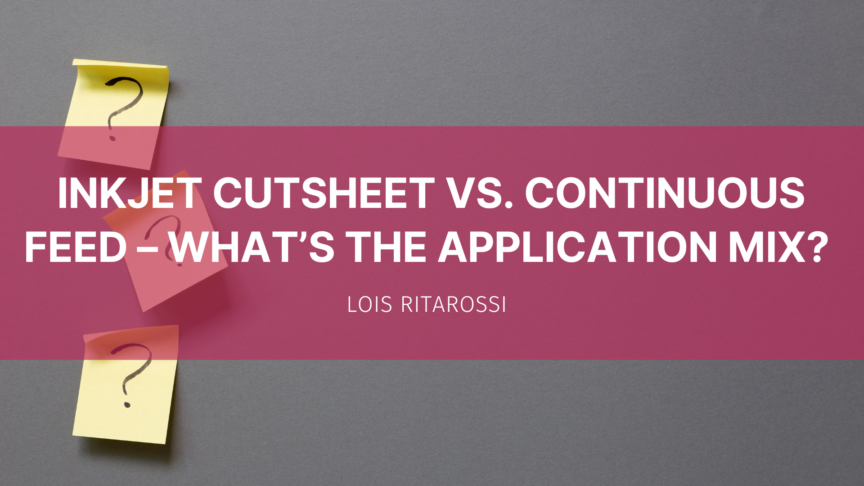It’s time to start executing plans to achieve your goals for 2024. Many print operations are considering new inkjet investments to realize their strategic goals. There are many cutsheet and continuous feed production inkjet options to choose from, with more product announcements expected before the drupa trade show. You can read more about the new inkjet options in What is ‘Production Inkjet’ Today?
When I am asked “what is the right solution for a specific operation?” I must give the consultant’s answer, it depends.
The right choice
The right choice for your operation depends on many things. In the recent past, a cutsheet or continuous feed decision was a straightforward volume-based analysis. Today the right solution for your shop depends on evaluating and ranking several criteria, including both qualitative and quantitative information. Criteria for analysis has expanded to include labor, cost, flexibility, substrates, image quality, area coverage, sheet size, throughput, new capabilities, finishing, automation, workflow integration, service, and total footprint.
Selecting the best inkjet device for your operation depends on your organization’s evolution and vision for the future. Has your shop evolved from mainframe and legacy printing? Is there a history of offset and digital printing? Does your operation print more than documents? Do you currently operate any inkjet technology?
Workflows must evolve as new equipment is installed. I have seen cutsheet-only digital shops install continuous feed inkjet. In-plants and commercial printers have replaced cutsheet offset with continuous feed inkjet. Some operations have replaced older toner or first-generation inkjet continuous feed with cutsheet platforms. The decision depends on the mix of applications, and goals for automation and growth. Management also needs to calculate the total cost of manufacturing and the time to market for finished products. With the ability to support printing of signage, labels, packaging, textiles, and other industrial applications, production inkjet can expand opportunities for new capabilities and new markets.
Why inkjet now?
Does your operation have a defined strategic goal to reduce costs, reduce work in process, or get more production done with less labor? Are customers asking for better solutions for personalization and customization? Cutsheet and continuous feed inkjet platforms can improve many operational challenges. The mix of applications and the number of base stocks will influence your decision.
The analysis should also weigh the business goals inkjet will address. Is the primary use case to supplement existing production with new capabilities for personalization, versioning or new customers? Will inkjet primarily complement current capabilities with more flexibility for shorter runs? Or is the focus for inkjet to replace older technology and improve workflow and automation. This article explains how offset printers are evaluating their decisions to move to inkjet.
With new inkjet platforms, the criteria that often determines the best decision between cutsheet and continuous feed is where workflow automation can reduce total time for manufacturing. Engage a consultant – or work with the solution architects from the equipment manufacturers – and conduct a detailed analysis of your current workflow. Map the process from the receipt of jobs and file preparation through proofing, production, and finishing. This type of workflow analysis will demonstrate opportunities to automate and eliminate touch points. It will likely provide clarity whether cutsheet or continuous feed will have a bigger impact on your production process. Your decision should also be informed by multiple configuration options for sheet size, web width and the necessary investment in finishing to efficiently produce important jobs. Inkjet can significantly improve turnaround and reduce labor by eliminating proofing and job set-up while also automating finishing.
The variable cost of production inkjet is determined by area coverage and the amount of ink used for recurring customers and large volume applications. Most OEMs provide speed and ink options which directly impact throughput, image quality (IQ) and the cost of ink per job. Running test jobs at different speeds on different stocks will inform your decision about the best options that meet customers’ requirements for turnaround, IQ and cost. I have seen in-plants and commercial printers move jobs from offset and toner printers to inkjet without notifying their clients. In contrast I have also observed lengthy review cycles with clients prior to inkjet migration to gain customer alignment on speed, paper, and IQ choices.
There are now cutsheet options that require a significant footprint and continuous feed presses with modules allowing for a smaller footprint than previous models. Space requirements can often dictate the decision for cutsheet over continuous feed.
Define your operational goals
Inkjet can provide a path forward to address the labor challenges of aging and retiring employees. Many in-plant print operations are decommissioning offset presses as their press operators retire. Inkjet’s success stories demonstrate the ability to hire and train less skilled employees. These new employees are able to become fully functional operators faster when compared to offset and toner devices. Here’s a past article that explains how inkjet is making staffing easier.
The equipment cost analysis of the various inkjet platforms is just the starting point. The most successful inkjet implementations have set clear goals for operational efficiency. Cost is one important criterion and often there are larger goals inkjet can address. Changing your workflow is much harder than installing a new press. One inkjet press can easily replace three or four toner devices and eliminate most pre-press and set-up for offset printing. The best choice for your operation is the one that addresses your specific business and operational goals. If you need further input on how best to conduct an analysis for your inkjet journey, please find my contact information on the contributor page.

